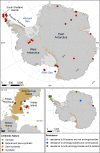Antimicrobial resistance in Antarctica: is it still a pristine environment?
- PMID: 35524279
- PMCID: PMC9072757
- DOI: 10.1186/s40168-022-01250-x
Antimicrobial resistance in Antarctica: is it still a pristine environment?
Abstract
Although the rapid spread of antimicrobial resistance (AMR), particularly in relation to clinical settings, is causing concern in many regions of the globe, remote, extreme environments, such as Antarctica, are thought to be relatively free from the negative impact of human activities. In fact, Antarctica is often perceived as the last pristine continent on Earth. Such remote regions, which are assumed to have very low levels of AMR due to limited human activity, represent potential model environments to understand the mechanisms and interactions underpinning the early stages of evolution, de novo development, acquisition and transmission of AMR. Antarctica, with its defined zones of human colonisation (centred around scientific research stations) and large populations of migratory birds and animals, also has great potential with regard to mapping and understanding the spread of early-stage zoonotic interactions. However, to date, studies of AMR in Antarctica are limited. Here, we survey the current literature focussing on the following: i) Dissection of human-introduced AMR versus naturally occurring AMR, based on the premise that multiple drug resistance and resistance to synthetic antibiotics not yet found in nature are the results of human contamination ii) The potential role of endemic wildlife in AMR spread There is clear evidence for greater concentrations of AMR around research stations, and although data show reverse zoonosis of the characteristic human gut bacteria to endemic wildlife, AMR within birds and seals appears to be very low, albeit on limited samplings. Furthermore, areas where there is little, to no, human activity still appear to be free from anthropogenically introduced AMR. However, a comprehensive assessment of AMR levels in Antarctica is virtually impossible on current data due to the wide variation in reporting standards and methodologies used and poor geographical coverage. Thus, future studies should engage directly with policymakers to promote the implementation of continent-wide AMR reporting standards. The development of such standards alongside a centralised reporting system would provide baseline data to feedback directly into wastewater treatment policies for the Antarctic Treaty Area to help preserve this relatively pristine environment. Video Abstract.
Keywords: Aminoglycosides; Anthropogenic; Efflux pumps; Horizontal gene transfer; Metagenomics; Sewage; Wastewater treatment; β-Lactam.
© 2022. The Author(s).
Conflict of interest statement
Competing interests
The authors declare that they have no competing interests.
Figures

Similar articles
-
Emerging Trends in Antimicrobial Resistance in Polar Aquatic Ecosystems.Antibiotics (Basel). 2025 Apr 10;14(4):394. doi: 10.3390/antibiotics14040394. Antibiotics (Basel). 2025. PMID: 40298543 Free PMC article. Review.
-
Assessing the impact of sewage and wastewater on antimicrobial resistance in nearshore Antarctic biofilms and sediments.Environ Microbiome. 2025 Jan 20;20(1):9. doi: 10.1186/s40793-025-00671-z. Environ Microbiome. 2025. PMID: 39833981 Free PMC article.
-
Merging Metagenomics and Spatial Epidemiology To Understand the Distribution of Antimicrobial Resistance Genes from Enterobacteriaceae in Wild Owls.Appl Environ Microbiol. 2020 Oct 1;86(20):e00571-20. doi: 10.1128/AEM.00571-20. Print 2020 Oct 1. Appl Environ Microbiol. 2020. PMID: 32769191 Free PMC article.
-
Anthropogenic environmental drivers of antimicrobial resistance in wildlife.Sci Total Environ. 2019 Feb 1;649:12-20. doi: 10.1016/j.scitotenv.2018.08.180. Epub 2018 Aug 16. Sci Total Environ. 2019. PMID: 30170212
-
'Disperse abroad in the land': the role of wildlife in the dissemination of antimicrobial resistance.Biol Lett. 2016 Aug;12(8):20160137. doi: 10.1098/rsbl.2016.0137. Biol Lett. 2016. PMID: 27531155 Free PMC article. Review.
Cited by
-
A mobile target.Elife. 2023 Mar 8;12:e86697. doi: 10.7554/eLife.86697. Elife. 2023. PMID: 36884273 Free PMC article.
-
Integrating the milk microbiome signatures in mastitis: milk-omics and functional implications.World J Microbiol Biotechnol. 2025 Jan 18;41(2):41. doi: 10.1007/s11274-024-04242-1. World J Microbiol Biotechnol. 2025. PMID: 39826029 Free PMC article. Review.
-
Emerging Trends in Antimicrobial Resistance in Polar Aquatic Ecosystems.Antibiotics (Basel). 2025 Apr 10;14(4):394. doi: 10.3390/antibiotics14040394. Antibiotics (Basel). 2025. PMID: 40298543 Free PMC article. Review.
-
Phenotypic and resistome analysis of antibiotic and heavy metal resistance in the Antarctic bacterium Pseudomonas sp. AU10.Braz J Microbiol. 2023 Dec;54(4):2903-2913. doi: 10.1007/s42770-023-01135-7. Epub 2023 Oct 2. Braz J Microbiol. 2023. PMID: 37783937 Free PMC article.
-
High throughput screening for human disease associated-pathogens and antimicrobial resistance genes in migratory birds at ten habitat sites in China.BMC Microbiol. 2025 Jun 6;25(1):355. doi: 10.1186/s12866-025-04059-4. BMC Microbiol. 2025. PMID: 40481427 Free PMC article.
References
-
- O’Neill J. Tackling drug-resistant infections globally: final report and recommendations. London: Government of the United Kingdom; 2016.
-
- World Health Organization (WHO) Global Antimicrobial Resistance and Use Surveillance System (GLASS) Report: early implementation 2020. Geneva: WHO Press; 2020.
-
- Sriram A, Kalanxhi E, Kapoor G, Craig J, Balasubramanian R, Brar S, Criscuolo N, Hamilton A, Klein E, Tseng K, Van Boeckel T, Laxminarayan R. State of the world’s antibiotics 2021: a global analysis of antimicrobial resistance and its drivers. Washington DC: Center for Disease Dynamics, Economics & Policy; 2021.
Publication types
MeSH terms
Substances
LinkOut - more resources
Full Text Sources
Medical

